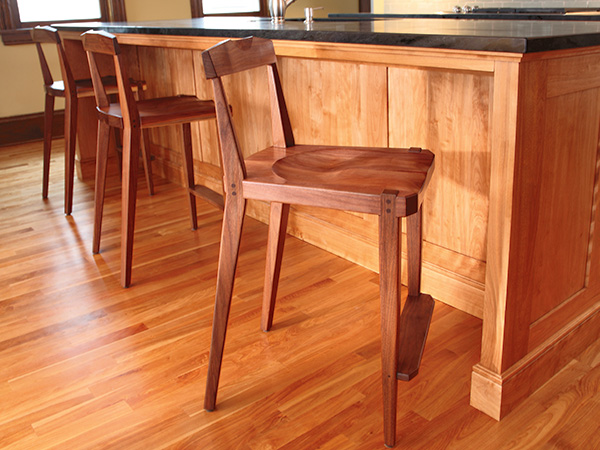
Chair building is what I do. Oh, I’ve made a lot of other sorts of woodworking projects in my career, but my specialty is making chairs and benches (and, of course, tables that the chairs are suited to). Those of you who know a bit about woodworking, and specifically understand how challenging chairs can be to build, may wonder why I would choose to make chairs my main gig.
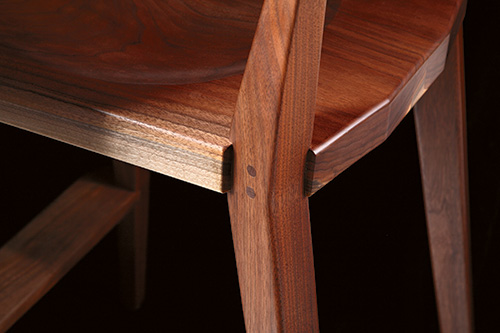
Sometimes, I wonder why, too. In addition to the truism that good, solid chairs are hard to build is the corollary that attractive chairs are challenging to design. It is so easy to over- or underbuild, for the chairs to turn out clunky or spindly. And if that was not enough, even if a chair looks beautiful and is as sturdy as the Rock of Gibraltar, if it is uncomfortable, all the aesthetics and strength are all for naught. But like I said, building chairs is what I do.
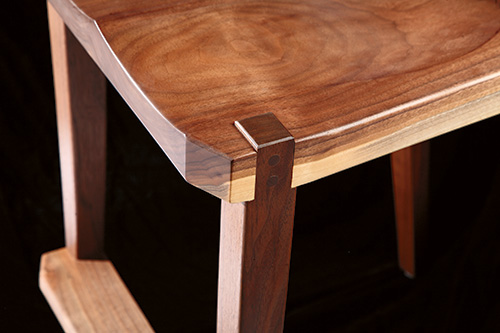
These chairs were designed and made on commission, like most of my furniture. In this case, the client had a large black walnut in their backyard which had to be cut down. They had the tree cut up into lumber, and that is when they contacted me.
Starting Out
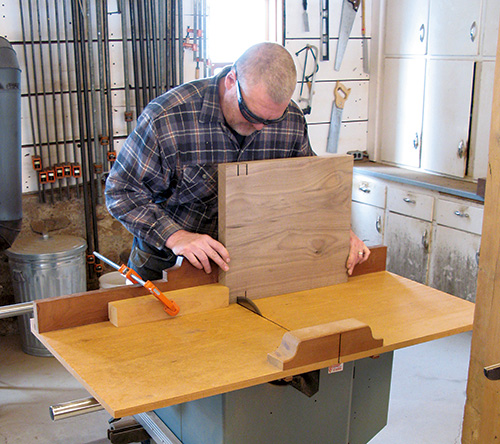
After the design was agreed upon, I began by selecting lumber for the seats, the component that literally holds the chair together. When you have a whole tree’s worth of lumber, that task is a bit daunting. The surfaced 8/4-boards (2″-thick) that would compose the seat blanks needed to be more than 8″ wide so that I could glue up the blank to a minimum of a 17″ wide piece, slightly wider than the finished dimensions found for the seat in the Material List.
As these seats are one of the main visual components of the chair, I took great care to select stock that had attractive grain that would be complemented further as I shaped the chair seats. Cut the pieces to 18-1/2″ lengths and then glue up the seat blank, taking care to align the pieces as perfectly as you can. After the glue cures, cut them to the exact size indicated in the Material List, and then sand them flat, up through 220-grit.
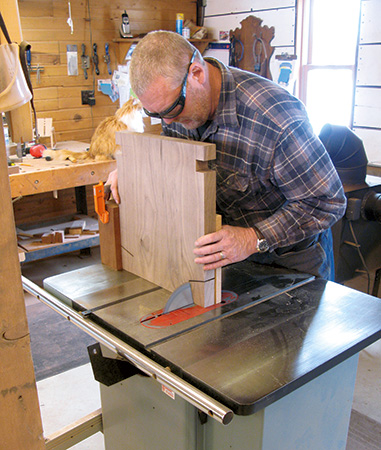
The next step is forming the notches that will accept the legs. You can find the locations for the notches in the Drawings. I find that the openings for the front legs are most easily cut using a crosscut jig (top photo, above) on my table saw. I clamp a stop block in place that locates the first cut, to make the back cut of the notched opening. If you are making more than one chair, as I did in this case, go ahead and make all the corresponding cuts on all the seat blanks. Following that, reset your stop block so that you can make the forwardmost cut of the leg mortise. Once you have made all those cuts, nibble out the waste to complete the opening. I clean up any tiny grooves or unevenness created by the nibbling process by paring the surface smooth with a sharp chisel. But here is an important point: because I used a saw blade that cuts a flat bottom in its kerf, I have very little cleanup to do — which makes the whole process more accurate.
Now it’s time to form the notches on the rear “corners” of the seat. As you can see from the seat plan Drawing, the seat’s shape will not remain rectangular. But the good news is, right now you will be working with the squared-up blank. I attach a large support board to my table saw’s miter gauge with screws and, once again, clamp a stop block to be certain of an accurate cut. There is a 15° splay to the rear legs, so I set the table saw blade at 15° before I cut. These notches come out clean with the second pass, so it’s a faster process.
Carving the Seat Contours
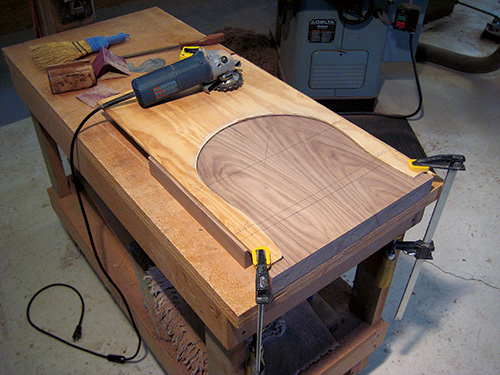
Now you are ready to shape the seat’s contours. I’ve seen many methods for forming these recesses, but as a guy who does a lot of chairs, I find my method to be the most efficient.
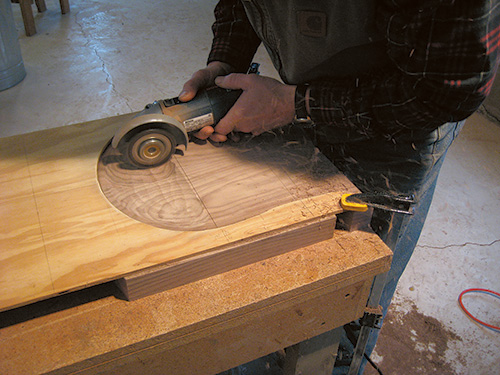
First, I make a template out of thin plywood that helps contain the shape of the contours. There is a template pattern for this chair’s seat above. Then I lay out a series of lines on the chair blank that locate the areas of the seat where the depth of the contours flow from one depth to another. Then I start machining the shape with a handheld grinder. I check and monitor the depth of my work using a straightedge and 6″ metal rule.
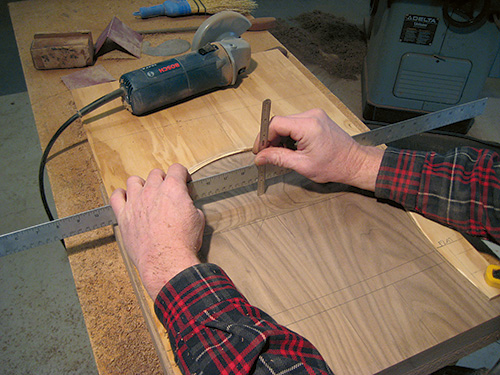
I rough out the shape with a grinder, then switch to an abrasive wheel that mounts on the same tool. I continue to shape the contours, completing the process with scrapers and rasps and finishing with a handheld disc sander.
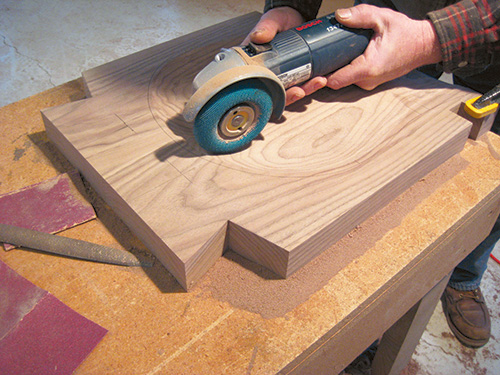
By using the template and working to predetermined rough depths, you will get identical- looking shapes on your seats. As I mentioned earlier, these seats are really important to the overall look of the chairs, so take your time and get the contours right.
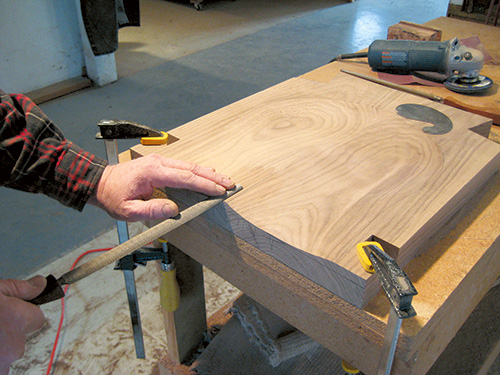
With that step in the rearview mirror, you have to cut the perimeter shape of the seat. Mark the shape using a template, and step over to your band saw to make your cut. Be sure to cut to the outside of the marked line — then step to a disc or horizontal belt sander to sand exactly to the line.
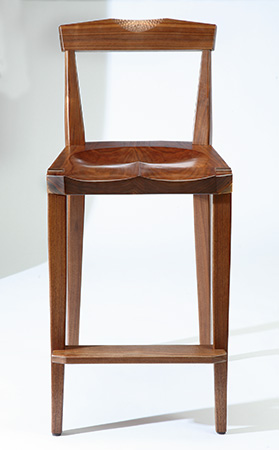
I use a handheld disc sander, hand sanding with a sanding block to complete the edge. I use a 1/4″ bearing-guided roundover bit to shape the top and bottom edges of the seat, staying clear of the leg notches. A touch more hand sanding, and then you can set the seats aside until you start to assemble the chair.
Shapely Legs
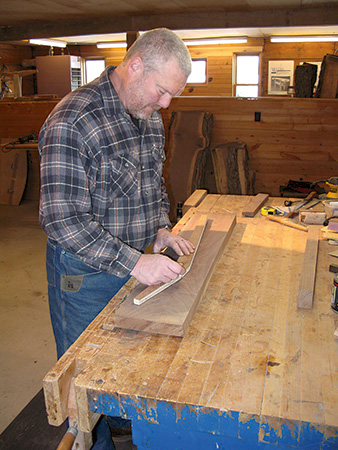
The front and back legs are next on the agenda. As is common with good chairmakers, I select riftsawn stock to make chair legs. The riftsawn figure looks pretty much the same on all four main faces of the legs — so the wood figure is not distractingly different on adjacent faces.
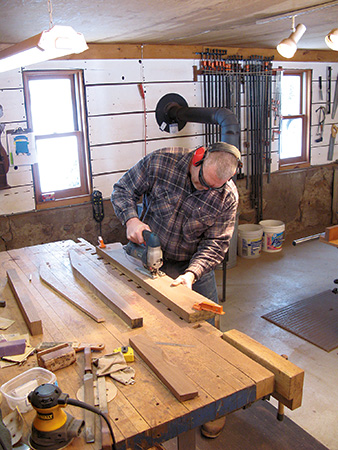
The front leg is 1-3/4″ square for its width and thickness. Cut them exactly to length, and then move to the table saw to raise the tenon on the end. This must fit tightly in the notch you formed in the seat blanks. I set the blade on my saw to 1/4″ high and sliced the shoulders of the tenon (see the Drawings).
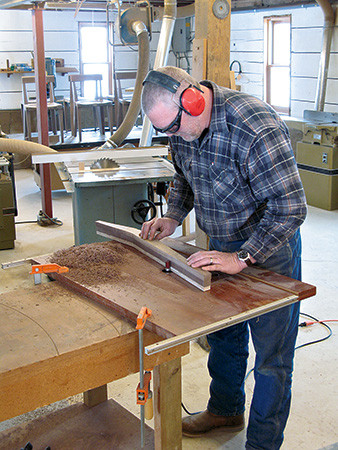
Following that, I used a typical tenoning jig on my saw to form the three faces of the tenon (technically, they would be called the cheeks, but that term seems a bit out of place when you are looking at the legs). When you have done this on all the legs, divide them into rights and lefts and mark where the notches (again, technically dadoes or housings) for the footrest will go.
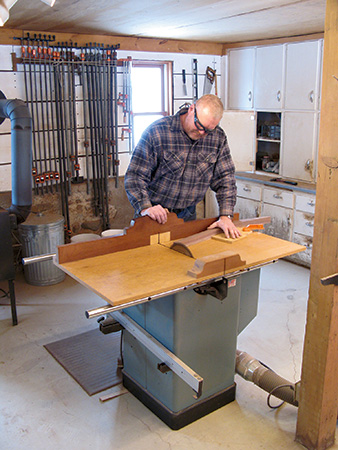
Mount a 3/4″ dado head in your table saw and make the cuts 7/16″ deep. Now taper all four sides of the legs to match the details in the Drawings. I use a shop-made tapering jig, but any method will do. When you are done with that, break the edges with a 1/4″ roundover bit in your router table. Keep it away from the shoulders of the tenons! I prefer to sand the front legs at this point in the process…it just gets the task out of the way. When you’ve carefully gone all the way up through 220-grit, you can set them aside and move on to the back legs.
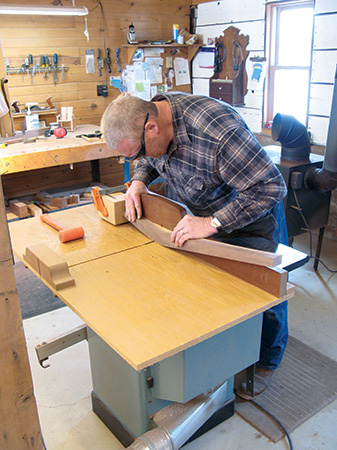
The back legs are a bit more complicated, as they have a little dogleg bend in them. I make an exact template of the side profile of the back legs from 1/2″ plywood. Then I use the template to lay out the leg on oversized stock, trying to match the flow of the grain in the wood to the bend in the leg.
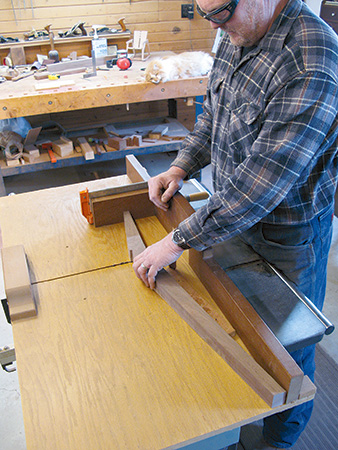
This detail makes the leg much stronger than if the grain ran off the leg shape (in other words, it avoids “short grain” issues). When you have marked out your legs on 1-3/4″ thick stock, cut them out, staying just a hair outside of the lines. A band saw will work well for this task, but I just use a good quality jigsaw to do the cutting.
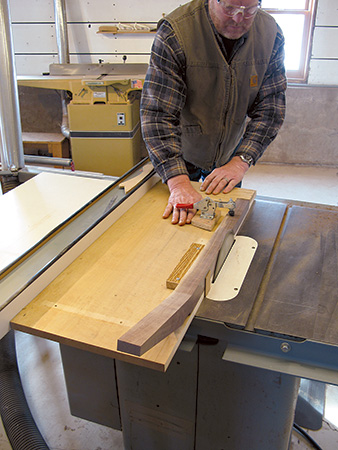
Then, chuck a pattern-routing bit into your router table and use the template to perfectly shape the legs. I use short tacks to attach the template, because later the legs will be tapered and the tiny nail holes will be cut off. An important note: don’t attempt to rout across the end grain of the legs — it presents too great a possibility for chipping and tearout (which would be a huge problem at this point in the process). After you’ve pattern routed the legs to shape, use a crosscut jig on the table saw to slice the ends of the legs to their proper angle and length.
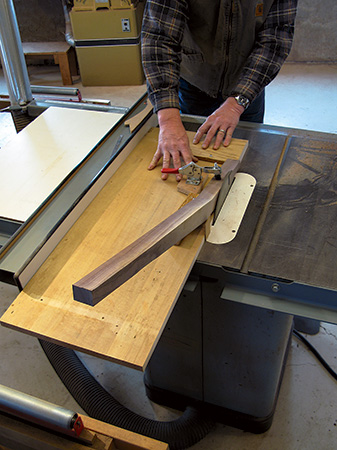
I chose to make notches (OK, they’re dadoes) where the legs join the seat for added strength and stability. I located the back notches while the front legs were fitted into the seats; see the note on the Drawings. I formed them on my table saw using my crosscut jig with a temporary fence screw in place. As with the tenons on the front legs, this is where you have to choose right and left legs, and machine them accordingly.
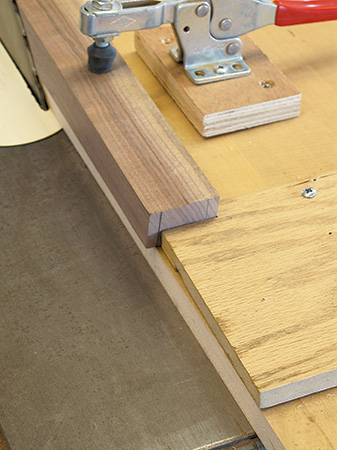
When that step is concluded, you need to finish tapering the back legs. This is a multi-step process for which I use a piece of plywood with screwed-on fences and a toggle clamp to keep my fingers safe. See the photos above for more details regarding this process. After the tapering is done, step back to the router table with the 1/4″ roundover bit and break the appropriate edges on the legs. Once again, after the major machining steps are done on the back legs, I get right to sanding them smooth.
Footrest and Crest Rail
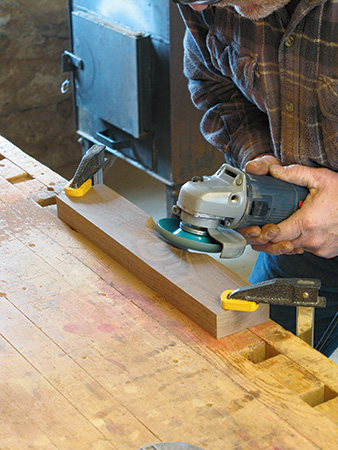
Making the footrest is fairly straightforward — use the Drawing and the dimensions found in the Material List to get you started. I like to clamp the chair together and fit the footrest in place, just to be certain that it is working out as I planned.
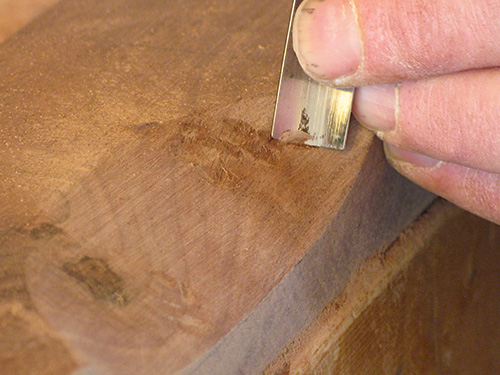
Once the footrails are made, you can go ahead and assemble the chairs, minus the crest rails, of course (because you haven’t made them yet). Pre-drill screw holes as shown in the Drawings, both the through holes in the legs and the pilot holes in the chair seat. I use 2″ Kreg Jig® hardwood screws with their flat shoulders, because their threads grab exceptionally well and they are very strong overall. Use glue in the joints and screw the components together securely. Wipe away any glue squeeze-out with warm water and a clean shop rag. Allow the glue to cure. You will need to plug the holes, and I like to make my own plugs from the wood that I am using to make the chair, rather than purchase pre-made plugs. I use a plug cutter on my drill press and sort through the plugs to get a good color match. It is a small detail that makes a big difference in my mind. One trick that I do to prepare the ends of the back legs for the crest rail is this: I take a 30″ or so piece of 1″ stock and wrap 100-grit sandpaper around it in two spots that correspond to the distance apart that the end of the back legs are. Then, holding the sandpaper square to the ends of the legs, I sand back and forth to even the ends of the legs.
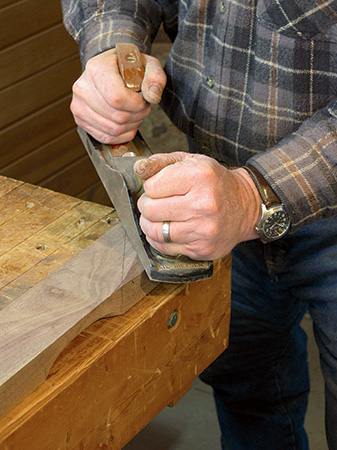
The crest rail looks rather simple, but it actually requires a fair bit of machining. The scooped-out and carved area on the crest rails is formed using my handheld grinder, then I do the dimple carving with a curved gouge. Then I trim the top edge of the crest rail to shape, so that I get a clean top edge. If you look closely at the lead image, you may notice on the back face of the crest rails there are a couple of triangular areas that are planed onto each end of the rail. This gives the crest rails a bit of additional shape, adding a degree of visual interest to the piece. I form them using a bench plane as shown.
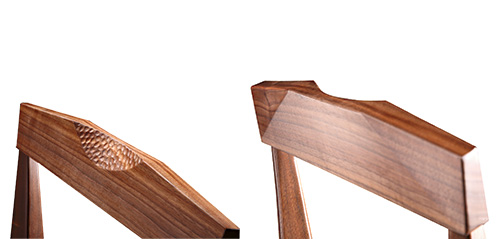
Now it is time to locate the dowels that will join the crest rails to the back legs. As with many woodworking tasks, there is more than one way to skin this cat, but I take a small brad nail and tap it into the center of the top of each back leg. I nip it off, leaving just about 1/8″ exposed. Then I carefully position the crest rail and tap the top edge with a rubber mallet above each leg. This gives me the location to drill for the dowels. I pull the brads out of the top of the legs and use a brad point drill bit to bore a hole to accept the dowels. Then I take the crest rail to my drill press and bore the corresponding holes into the rail. I use a small fixture, just an angled piece of wood really, to hold the crest rail at the proper angle when the dowel hole is being drilled. Now it is time to cut the angles onto the ends of the crest rails. Sand the crest rails before you attach them to the chair — trust me, it is easier.
Test fit the crest rail to the chair, make any additional adjustments that might be required, and then clamp them in place using the dowels and glue. Wipe off any squeeze-out, then allow the glue to cure.
Final Details
Finishing is the next task on the docket, but not before you do a once-over final sanding. Check all the edges to make sure you didn’t dent or mar them durning assembly. With walnut, I like to wipe it down with a wet cloth to raise the grain, and then final sand to 220- or even 320-grit. Then I like to apply a good coat of Natural Watco Oil and allow it to dry for at least 48 hours. The Watco soaks into the wood fibers and really pops the grain. It also gets into the carved section of the crest rail and seals those exposed fibers. It is almost like it conditions the wood fibers and hardens them. Then I apply several coats of wipe-on polyurethane, with a rubdown of #0000 steel wool before the final coat. After the poly cures (at least seven days to cure completely), a rubout with paste wax and #0000 steel wool makes the finish feel like silk.
There you have it. The chair only has seven main components, but as you can see, that does not mean that it is a snap to make. Chairs never are. But this one is really not too hard, and if I do say so myself, it looks pretty good!
Click Here to Download the Drawings and Materials List.
– Greg Wood is a professional woodworker from Howard Lake, Minnesota. You can see more of his work (lots of chairs!) by going to www.gregwoodfurniture.com.





